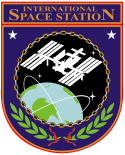Expedition 59
| Expedition 59 | |||
 | |||
| Uppdragsstatistik | |||
|---|---|---|---|
| Rymdstation: | ISS | ||
| Start: | 15 mars 2019[1] | ||
| Slut: | 24 juni 2019 | ||
| Antal besättningsmedlemmar: | 6 st | ||
| Rymdpromenad | |||
| Antal rymdpromenader: | 4 st | ||
| Total tid: | 25 timmar, 55 minuter | ||
| Transport | |||
| Uppskjutning: | med Sojuz MS-11, Sojuz MS-12 | ||
| Uppskjutningsplats: | Kosmodromen i Bajkonur | ||
| Landning: | med Sojuz MS-11, Sojuz MS-12 | ||
| Landningsplats: | Kazakstan | ||
| Kronologi | |||
| |||

Expedition 59 var den 59:e expeditionen till Internationella rymdstationen (ISS). Expeditionen började den 15 mars 2019 då Sojuz MS-12 dockade med rymdstationen.
Expeditionen avslutades den 24 juni 2019 då Sojuz MS-11 lämnade rymdstationen.
Besättning
| Position | (15 mars - 24 juni 2019) |
|---|---|
| Befälhavare | Hans fjärde rymdfärd |
| Flygingenjör 1 | Hennes första rymdfärd |
| Flygingenjör 2 | Hans första rymdfärd |
| Flygingenjör 3 | Hans andra rymdfärd |
| Flygingenjör 4 | Hans första rymdfärd |
| Flygingenjör 5 | Hennes första rymdfärd |
Referenser
- ^ ”NASA's Space Station Expedition 59” (på engelska). NASA. 12 mars 2019. Arkiverad från originalet den 10 april 2019. https://web.archive.org/web/20190410111220/https://www.nasa.gov/mission_pages/station/expeditions/expedition59/index.html. Läst 15 mars 2019.
Externa länkar
| |||||||||||||||||||||
Media som används på denna webbplats
The official insignia for the three-member Expedition 58 crew with Anne McClain of NASA, Oleg Kononenko of Roscosmos and David Saint-Jacques of the Canadian Space Agency.
- Thousands of people worldwide dedicate their lives to the human exploration of space. As one team, we strive to learn, discover and pioneer for the benefit of all mankind. The Expedition 58 patch is a crew tribute to those thousands who stand ready every day committed to supporting this mission.
- Central to the patch is the compass rose—a symbol of exploration past, present and future. The passing of the International Space Station from darkness into light suggests that we are only just peaking over the horizon, looking forward to advancing human understanding of our place in the universe.
- The crew of Expedition 58 are fortunate explorers … never alone in their journey. Among the night lights on the Earth are glints of brightness – the global team and major control facilities that keep the space station on orbit and its inhabitants on track.
- And as the explorers from centuries past used stars to guide their way, so too does the crew of Expedition 58. The stars on the Expedition 58 patch are their families, one star for each member. They shine on as a beacon of strength and a guiding light home.
The Expedition 59 crew insignia
- The Expedition 59 patch celebrates the International Space Station’s role as a microgravity science laboratory. The crew, made up of scientists, doctors, engineers and pilots, will conduct hundreds of experiments for the benefit of mankind and our fragile environment on planet Earth.
- The patch shape depicts the cupola windows. Through these windows, astronauts have made many significant observations of Earth’s ecosystems and they have discovered and documented real-time events like volcanic eruptions and earthquakes.
- The position of the Earth at the top of the patch depicts where the Earth would be seen by an astronaut from the cupola. It represents the explorers’ unique perspective on his or her home. The image at the center of the patch is the station itself, the largest single structure humans have ever put into space, an engineering marvel.
- The station is overlaid on an atom, the basic building block of all matter. The atom has three electron orbits with the flags of Russia, the United States of America and Canada, representing the home countries of the Expedition 59 crew. Like electrons in an atom, international cooperation is the basic stabilizing force that enables large scale space exploration.
- To achieve great deeds, humans from all across the globe must work together in peace with a shared vision. The Expedition 59 patch celebrates the massive scientific accomplishments of the space station while highlighting the importance of global teamwork in understanding our planet and continuing with bold exploration in the future.
The official Expedition 59 crew portrait with (from left) astronauts David Saint-Jacques of the Canadian Space Agency and Anne McClain of NASA; cosmonauts Oleg Kononenko and Aleksey Ovchinin of Roscosmos; and NASA astronauts Nick Hague and Christina Koch.
The Expedition 60 crew insignia
- The Moon landing is one of the most extraordinary feats of humankind, an embodiment of ingenuity and desire for exploration. The patch of Expedition 60 commemorates the 50th anniversary of that landing: a constellation of three stars with the Moon superimposed forms the letter “L,” the Latin symbol for 50. The Moon is depicted as a waxing crescent, as it was on July 20, 1969.
- The familiar silhouette of the International Space Station is visible, flying across the night sky. Stars, numerous and bright as seen from the space station, form the shape of an eagle in the same pose as on the iconic patch of the Apollo 11 mission. The sunrise represents the fact that we are still in the early stages of humanity’s exploration of space.
- The hexagonal shape of the patch represents the space station's cupola, with the six points of the hexagon symbolizing the six crewmembers of Expedition 60. The names and nationalities are not present, as on the original Apollo 11 mission patch, to highlight that space missions – then, now, and in the future – are for Earth and all humankind.








